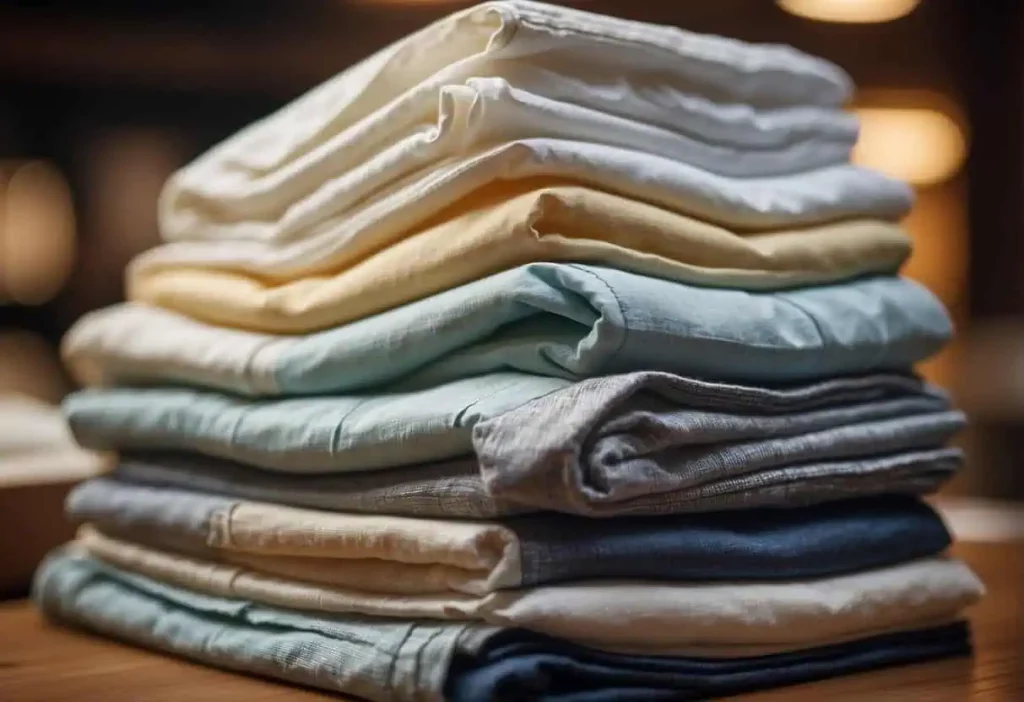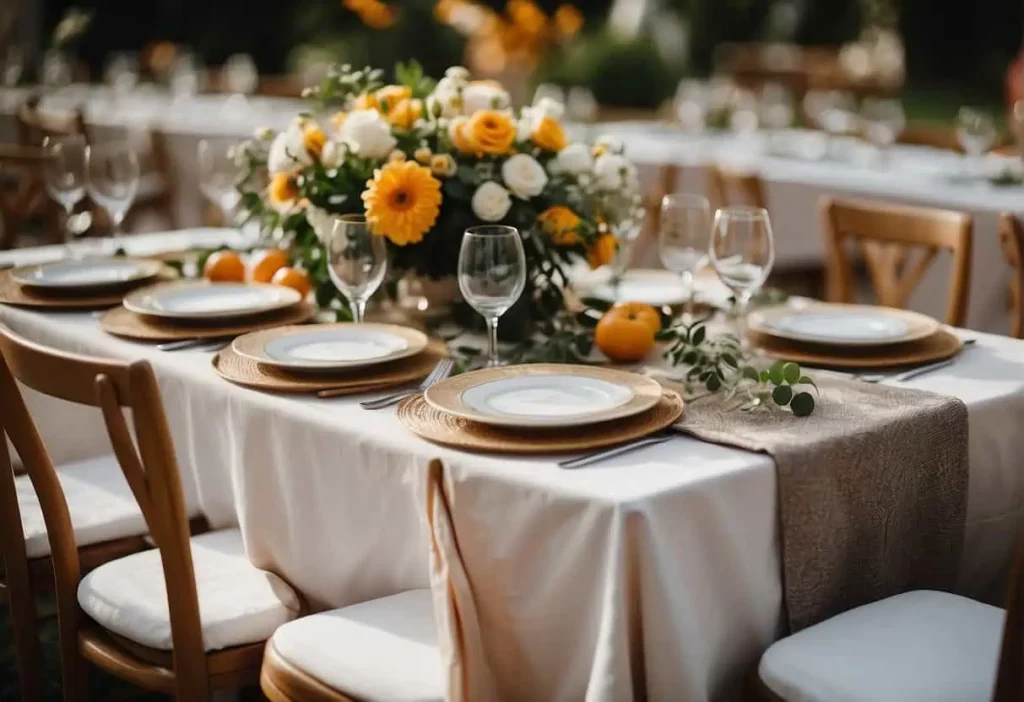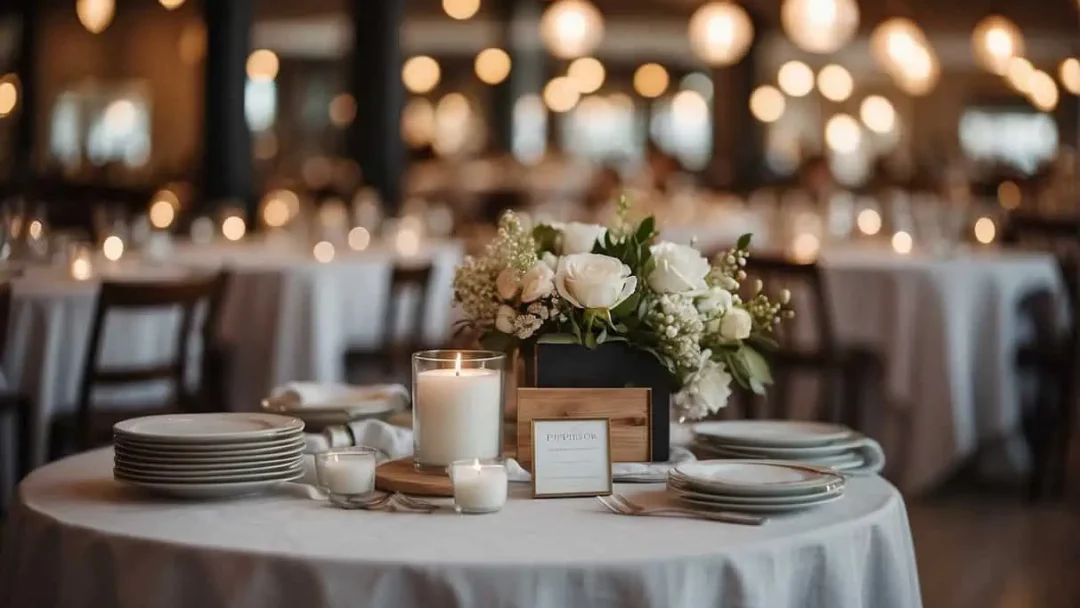When planning an event, one essential detail to consider is linen rentals, which add a touch of class and elegance to the decor.
The cost of renting linens can vary widely based on several factors, including the type of fabric, the size and quantity of linens needed, and the duration of the rental period.
Typically, tablecloths might range from $15 to a few hundred dollars each, with additional items such as napkins and table runners carrying varying costs.
Understanding the pricing and options available for linen rentals is crucial for budgeting and ensuring your event carries the aesthetic theme you envision.
The selection process for event linens involves more than just picking out colors and fabrics; it requires coordination with the venue and consideration of the event type.
For instance, high-end materials such as satin may increase the cost, whereas polyester blends offer a more budget-friendly option.
Timing is also a key factor, as peak seasons and high-demand times can affect availability and pricing.
It’s important to inquire about the full scope of services provided, including set-up, delivery, and pick-up, as well as any additional insurance or maintenance fees that may apply.
Key Takeaways
- Linen rental costs fluctuate based on fabric types, event size, and service scope.
- The event type, venue, and timing influence linen selection and availability.
- Renting linens involves additional considerations such as color scheme and design.
Understanding Linen Rentals
When planning an event, understanding the nuances of linen rentals is crucial. Linen rentals provide an essential decorative touch that can elevate the ambiance of any occasion.
Typically, linen rentals cover a wide range of items including tablecloths, napkins, chair covers, and sashes.
Quality and fabric type are significant factors affecting both the appearance and the cost of linen rentals.
Common fabrics include:
- Polyester: Economical and durable, with a wide color range.
- Satin: Offers a glossy finish, adding a touch of elegance.
- Lace: Delicate and intricate, suitable for vintage themes.
- Cotton: A versatile choice, often used for its natural feel.
- Silk: Luxurious and smooth, with a naturally shimmering appearance.
- Velvet: Rich texture provides a plush look.
- Taffeta: Crisp and smooth, with a slight sheen.
- Damask: Woven with a mix of matte and satin weaves for a subtle pattern.
- Organza: Sheer and lightweight, perfect for overlays.
Costs can vary from a few dollars for a simple table linen to several hundred dollars for high-end options. Factors influencing price include:
- Size and Shape: Larger and uncommon shapes can increase the price.
- Design Details: Special embellishments, such as embroidery or sequins, often add to the cost.
Additional expenses to consider may involve insurance policies, delivery, setup, and pick-up services.
Effective planning requires balancing budget constraints with the desired aesthetic to ensure both financial and design goals are met.

Types of Linens for Events
When planning an event, selecting the correct linens can significantly enhance the ambiance. Linen rentals offer a variety of items tailored to meet the aesthetic and functional requirements of an event.
Tablecloths are foundational linens, providing a base for table settings. Available in various materials, like polyester for durability and satin for a more sophisticated look, they come in different sizes to fit an assortment of table configurations.
Overlays and table runners add depth and interest to tablescapes.
Overlays lie on top of tablecloths and often feature intricate patterns or luxe fabrics, while runners traverse the length of the table, creating a streamlined look. They can incorporate sequins or other decorative embellishments for added sparkle.
For seating, chair covers transform ordinary chairs into elegant pieces that complement the event’s theme. These covers can be paired with chair sashes, which are bands of fabric tied around the chair back for a pop of color and texture.
Napkins serve a dual purpose: practicality and decoration. Quality napkins that feel pleasant to touch elevate the guest experience.
Lastly, drapes can adorn not only windows but also serve as elegant backdrops or room dividers within a venue.
| Linen Type | Function | Material Options |
|---|---|---|
| Tablecloths | Base for table setting | Polyester, Satin |
| Overlays | Decorative top layer | Various fabrics |
| Runners | Accent feature for tables | Varied textures |
| Chair Covers | Aesthetic upgrade to chairs | Stretchable, fitted fabrics |
| Napkins | Hospitality and decor element | Cotton, Linen |
| Sashes | Color and texture for chairs | Satin, Organza |
| Drapes | Venue embellishment/dividers | Heavy, flowing fabrics |
The precise selection should account for the event’s theme, the venue’s style, and functionality, ensuring that the linens enhance the overall event experience.
Event and Venue Considerations
When renting linens for an event, it’s essential to assess the event space and venue.
The size and number of tables directly influence the quantity of linens needed.
Typically, round tables require larger tablecloths compared to square or rectangular ones, and ballrooms may require grander, more elegant drapes. A wedding planner can offer expertise in estimating the necessary amounts.
For wedding receptions, specific designs and types of linen need to be chosen that complement the couple’s aesthetic.
Chairs also need to be considered; chair covers can transform venue chairs to align with the desired theme.
Season and location play roles in determining the appropriate fabric type—lighter materials for summer or outdoor events, and heavier ones for cooler climates.
| Venue Type | Linen Considerations |
|---|---|
| Outdoor | Weather-resistant and secured linens |
| Ballroom | Luxurious, coordinating drapes and tablecloths |
| Reception Halls | Linens that match the theme and decor |
Venues may have restrictions or provide certain linens, thus it’s critical to consult with them.
The availability of certain linen styles may vary by location, with some regions having more options due to local suppliers.
One should consider working closely with rental companies to ensure the chosen linens are suitable for their specific venue and event needs, exploring the range of available fabrics, colors, and designs that can add elegance and charm to the occasion.
Rental Process and Options
When considering linen rentals, customers typically follow a process that begins with obtaining a quote.
This quote will be based on their budget and specific needs such as the event size and linen quality.
Renters should ensure the quote includes all potential fees for delivery, setup, maintenance, and additional services.
Most rental companies offer a variety of linens, allowing for extensive customization options to match the event’s theme. Available choices commonly include:
- Polyester Tablecloths: Standard and affordable
- Satin Tablecloths: A sleek, glossy finish
- Specialty Linens: Unique fabrics and designs
Setup services are available where the company arranges the linens at the venue. Clients may also opt for self-setup to reduce costs.
Delivery and logistics are usually handled by the rental company, with costs sometimes included in the rental fee.
The customer should confirm the return policy, as well as any maintenance fees for laundering or repairing damaged linens.
Purchase might be an option for those seeking to own the linens outright. This is a consideration if the linens will be used repeatedly over time.
Rental companies typically have policies covering damages or staining; renters are advised to inquire about an insurance policy which might be included or available at an additional charge.
Color and Design Selection
Selecting the ideal colors and designs for linen rentals plays a crucial role in harmonizing the aesthetic of an event.
These elements are pivotal in enhancing the overall atmosphere, especially for occasions such as weddings where the decor sets the stage for celebration.
Choosing the Right Colors
When selecting colors for linen rentals, event planners should consider the season, venue, and time of day.
For instance, lighter shades might suit a daytime garden wedding, while richer tones could complement an evening event.
One must also account for the psychological impact of colors—cool blues and greens typically evoke calmness, whereas warm reds and yellows bring energy to the setting.
- Seasonal Colors:
- Spring: Pastels like mint and blush
- Summer: Vibrant colors such as turquoise or coral
- Fall: Earthy tones like burgundy or olive
- Winter: Deep hues including navy or emerald
- Time of Day:
- Daytime: Lighter, softer colors
- Evening: Darker, more saturated shades
Matching Linens with Event Decor
Linens should seamlessly integrate with other design elements.
Coordinating with the wedding decor, for instance, includes aligning with floral arrangements and centerpieces to ensure visual cohesion.
One may also consider the venue’s existing color scheme and ornamentation to select linens that both stand out and tie the elements together.
- Venue Considerations:
- Check if the venue has neutral tones or specific color themes.
- Determine the color of permanent fixtures and carpeting to avoid clashes.
- Textural Elements:
- Satin tablecloths offer a glossy, reflective quality for formal settings.
- Linen tablecloths present a grainy texture, suitable for rustic or vintage themes.

Cost Considerations
When planning an event, understanding the cost of linen rentals is crucial.
Linen rentals can include tablecloths, napkins, and covers, each with varying prices.
Polyester tablecloth rental typically ranges from $5-$10 per piece, while satin options may cost between $8-$15 per piece.
On the other hand, renting napkins can cost approximately $1 per piece.
Factors influencing pricing include:
- Fabric Choices: Durable fabrics like spun polyester are affordable, while specialty fabrics like satin or linen may be more expensive.
- Size and Quantity: Larger or more numerous items require a higher budget.
- Event Duration: Longer events may incur additional costs for extended rental periods.
Additional fees to consider:
- Insurance: To protect against damage or spills.
- Delivery, Set-up, and Pick-up: These services can add to the cost unless self-handled.
For weddings, the typical expenditure on linen rentals ranges from $500 to $2,000, reflecting the premium for high-quality, elegant fabric options suited for such occasions.
Accessory and Ancillary Items
When planning an event, attention to detail is crucial, especially with accessory and ancillary items that supplement linen rentals.
These items not only complement the aesthetics but also serve functional purposes.
Cloth Napkins: They are a staple at any formal event. Typically, rental prices range from $0.40 to $1.00 per napkin, varying by material and design.
- Cotton or polyester napkins generally cost less.
- Satin or specialty fabric napkins may be priced higher.
Cake Table Linens: The table showcasing the cake is a focal point at many events. Renters can expect to spend from $10 to $30 for linens that elegantly drape the cake table, depending on size and fabric type.
Escort Cards and Guest Book Table: Linens for these tables should harmonize with the overall theme. A uniform look can cost between $5 and $20 per tablecloth. Adding overlays or runners can incrementally raise the price.
Event Enhancements:
- Lighting: Soft lighting can accentuate the linens and is worth considering.
- Centerpieces: They often serve as conversation starters and are coordinated with tablecloths for a cohesive look.
Seasonal and Peak Times
Linen rentals exhibit price fluctuations throughout the year, largely dictated by the season and specific peak times.
Typically, the wedding season, spanning from late spring through early fall, sees a surge in linen rental demands.
During these months, prices may increase as a result of heightened competition for resources.
Event planners are advised to book well in advance during these periods to secure availability and potentially better rates.
Conversely, the winter months often mark the off-peak season for linen rentals in many locations. This can present opportunities for cost savings.
Clients hosting events during this time might find lower prices and greater negotiation power due to decreased demand.
For holiday events or celebrations such as Christmas, New Year’s Eve, or Valentine’s Day, one might expect a transient spike in rental costs.
The demand for thematic linens can drive prices up due to the specialized nature of the products.
Here is a simplified breakdown:
- Peak Season (late spring to early fall):
- Higher prices
- Advance booking recommended
- Off-Peak Season (winter months):
- Potential for lower prices
- Increased negotiation power
- Holiday Events:
- Prices may increase due to specialized linen demand
One should also consider regional variations where certain locales might have different high and low seasons.
It is prudent for clients to inquire with rental companies for specific seasonal pricing and to consider these factors when budgeting for their events.
Vendor and Service Coordination
When organizing linen rentals, coordination with vendors is crucial for a seamless event setup.
Clients typically encounter a range of services that include delivery, setup, and pickup schedules, which must be managed effectively to avoid any logistical challenges.
Delivery and Setup: Vendors often provide specific windows of time in which they will arrive to deliver and arrange the linens.
It’s essential for the client to ensure the venue is accessible during these times and that there is a clear protocol for where and how the linens should be set up.
- Timeliness: Vendors should be punctual to maintain the event schedule.
- Venue Accessibility: Clients should confirm venue availability for setup.
Handling Damages and Accidents: Linen rental agreements often incorporate policies covering damages or accidents.
Understanding these terms is important, as it affects how one is liable for any spills or tears that might occur.
- Insurance: Some companies include insurance in the rental cost.
- Liability: Clients should be aware of their responsibilities for any damages.
Logistics Coordination: Effective communication between all parties – clients, vendors, and venue staff – is necessary to coordinate logistics.
The client usually has the responsibility to manage this communication, ensuring that each entity is informed of their roles and the event timeline.
- Communication: Regular updates can prevent misunderstandings.
- Responsibility Assignment: Clear delegation of tasks avoids confusion.

Advantages of Linen Rentals
Linen rentals offer numerous benefits for both individuals and businesses.
Renting linens, such as polyester tablecloths, can be a practical and cost-effective solution.
Cost Efficiency:
Renting linens can be more affordable than purchasing, especially for one-time or infrequent events.
Businesses avoid the high upfront costs of purchasing linen outright and can allocate resources more efficiently.
Maintenance:
One of the significant advantages of linen rental is the maintenance service.
Renters do not have to worry about washing or ironing the linens as this is usually taken care of by the rental company.
This ensures linens are always in pristine condition for use.
Quality and Variety:
Rental companies often provide a high standard of linen quality and offer a range of colors and styles.
Clients can select premium fabrics like satin tablecloths without the need to invest in a variety of linens for different occasions.
- Convenience: The convenience of using rental services is considerable. They typically offer delivery, set-up, and pick-up, simplifying the logistics of event planning.
- Additional Services: Many companies include additional services with linen rental. This may cover insurance to protect against damages and stains that can occur during use.
Utilizing linen rental services allows clients to present an elegant and professional image without the expense and hassle of owning and maintaining a linen inventory.
They can enjoy a diverse selection without the commitment to a single style, making it an attractive option for events and businesses looking to impress.
Frequently Asked Questions
When planning an event, one needs to consider linen rentals as a cost-effective and hassle-free option for table settings. The following FAQs provide insight into typical pricing and benefits of renting linens for events such as weddings.
What is the typical price range for wedding linen rentals?
Wedding linen rental prices can vary, typically ranging from $5 to $15 per piece.
Factors influencing cost include the fabric’s quality and the style of the linen.
How do tablecloth rental prices vary by region?
Prices for tablecloth rentals may be influenced by regional differences.
Urban areas often have higher rental costs compared to rural regions due to increased demand and operational expenses.
What advantages does linen rental offer over purchasing?
Renting linens can be more cost-effective than purchasing, especially for one-time events.
Rentals save storage space and eliminate the need for maintenance, while also providing a wide variety of style options.
How does the cost of linen rental services fluctuate seasonally?
Demand for linens may surge during peak wedding and holiday seasons, potentially leading to higher rental costs.
Conversely, prices may be lower during off-peak times as rental companies aim to maintain steady business.
What are the standard table linen sizes available for rent?
Linen rentals are typically available in a variety of sizes to fit standard table dimensions, from small round tables to large banquet-style seating.
Can you explain the pricing structure for different linen rental options?
Linen rental services usually price their offerings based on the type and quality of fabric. Premium options such as satin are priced higher than standard polyester linens. Additional factors may include the complexity of the design and the quantity required.

